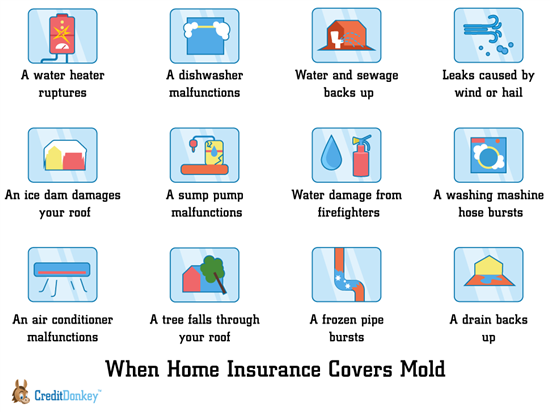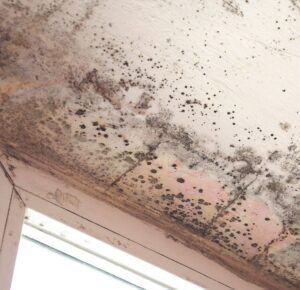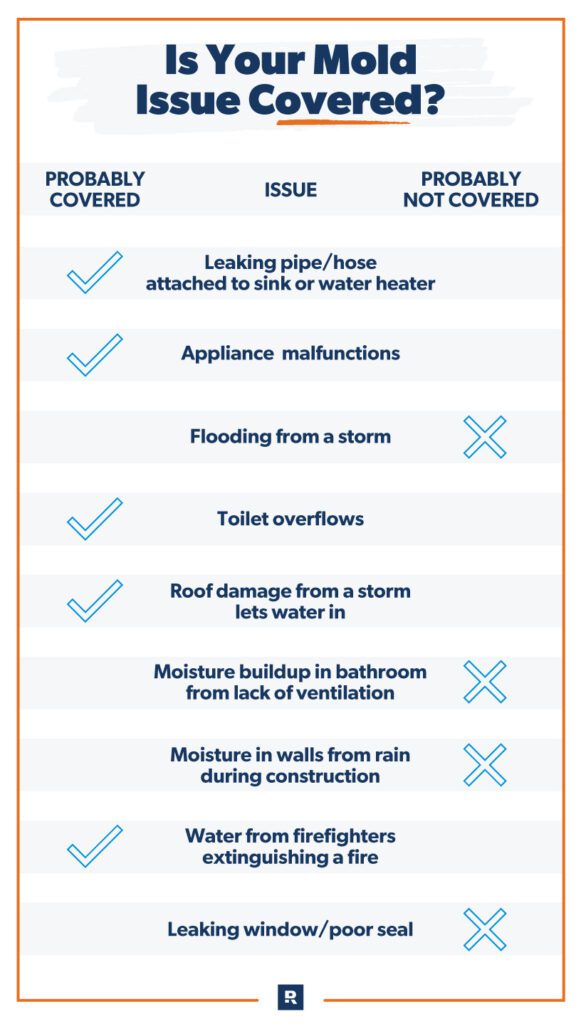Are you a homeowner in San Diego who is concerned about the presence of mold in your property? If so, you may be wondering if mold removal is covered by your homeowners’ insurance. In this article, we will explore the topic of mold removal in San Diego and whether or not it is typically covered by homeowners’ insurance policies. Understanding the ins and outs of insurance coverage for mold removal can help you make informed decisions and protect your home.
Understanding Mold and its Sources
Definition of Mold
Mold is a type of fungus that thrives in warm and damp environments. It can grow on various surfaces, such as walls, ceilings, carpets, and furniture. Mold reproduces by releasing spores into the air, which can easily spread and colonize new areas. While some mold species are harmless, others can pose health risks and cause damage to structures.
Common Sources of Mold Growth
Mold can grow in many areas of a home, particularly in spaces with high humidity or moisture levels. Common sources of mold growth include:
-
Water Leaks: Leaky pipes, roofs, or windows can provide the ideal conditions for mold growth. Any area affected by water damage is at a higher risk of developing mold.
-
Poor Ventilation: Insufficient airflow can result in excess moisture buildup, leading to mold growth. Bathrooms, kitchens, and basements are often more susceptible to mold due to inadequate ventilation.
-
Flooding: Homes that have experienced flooding, whether from natural disasters or plumbing mishaps, are particularly prone to mold growth if not properly dried and cleaned.
-
Condensation: Areas with high levels of condensation, such as windows, air conditioning units, or areas with temperature fluctuations, can create an environment conducive to mold growth.
Health Dangers Associated with Mold
Exposure to mold can have detrimental effects on your health. Some individuals may experience mild symptoms, while others may develop more severe reactions. Common health dangers associated with mold include:
-
Allergic Reactions: Mold spores can trigger allergic reactions in sensitive individuals, leading to symptoms such as sneezing, coughing, itching, and watery eyes.
-
Respiratory Issues: Prolonged exposure to mold can exacerbate existing respiratory conditions, such as asthma or bronchitis, and may lead to the development of respiratory infections.
-
Skin Irritation: Direct contact with mold or its spores can cause skin irritation, leading to rashes, itching, and redness.
-
Toxic Reactions: Certain mold species produce mycotoxins, which can result in toxic reactions when inhaled or ingested. These reactions can vary in severity and may lead to neurological symptoms, organ damage, or even death in extreme cases.
Homeowners’ Insurance Coverage for Mold Removal
General Coverage
Homeowners’ insurance policies typically cover mold removal as long as it is a result of a covered peril, such as a burst pipe or a leaking roof. However, the extent of coverage and limitations can vary between insurance companies and policy terms. It is essential to review your policy carefully to understand the specific coverage you have for mold damage and removal.
Policy Limitations and Exclusions
While some policies offer comprehensive coverage for mold removal, others may have limitations and exclusions. Common limitations include coverage caps, requiring the policyholder to pay a portion of the expenses, or excluding mold removal resulting from long-standing maintenance issues.
Specific Situations Covered by Insurance
Insurance policies may cover mold removal in specific situations, such as:
-
Sudden and Accidental Water Damage: If mold growth is a direct result of sudden and accidental incidents, like a burst pipe or a malfunctioning appliance, it is typically covered by insurance.
-
Storm or Weather-related Damage: Mold growth due to storm damage, such as a tree falling on your roof during a storm, may be covered by insurance.
-
Secondary Mold Damage: If mold growth is a direct result of a covered peril, such as water damage from a covered pipe burst, the removal costs may also be covered.
Factors Affecting Coverage Eligibility
Several factors can affect the eligibility of coverage for mold removal, including:
-
Evidence of Covered Peril: Insurance companies will require evidence that the mold growth is a direct result of a covered peril. It is crucial to document the cause and timeline of the mold growth and any incidents that led to water damage.
-
Timely Reporting: Promptly reporting any water damage or suspected mold growth to your insurance company is essential to initiate the claims process. Delays in reporting may result in coverage denial.
-
Regular Maintenance: Insurance policies may have exclusions for mold growth resulting from lack of regular maintenance. It is important to demonstrate that you have taken reasonable steps to maintain your property and prevent mold growth.

Determining Mold Damage Coverage
Insurance Claim Process
When filing an insurance claim for mold removal, it is essential to follow the proper procedures. The typical claim process involves:
-
Notification: Contact your insurance company as soon as mold growth or water damage is discovered. Be prepared to provide details about the incident and the extent of the damage.
-
Documentation: Document the damage by taking photographs or videos. Keep records of any correspondence or conversations with your insurance company.
-
Claims Adjuster Inspection: An insurance adjuster will visit your property to assess the damage and determine the coverage eligibility. Cooperate fully during the inspection and provide any requested documentation.
-
Claim Settlement: If your claim is approved, you will receive a settlement offer outlining the coverage for mold removal. Review the offer carefully to ensure it adequately addresses the damages.
Contractor Assessment and Report
Insurance companies may require a contractor’s assessment and report to support your mold removal claim. A licensed professional will evaluate the extent of the mold damage, recommend remediation measures, and provide an estimate of the associated costs. The insurance company may consider this report in determining the coverage amount.
Extent of Mold Damage
The extent of mold damage plays a significant role in determining insurance coverage. Insurance policies may have different coverage limits based on the level of damage, the affected area, and the cost of remediation. It is crucial to work with a qualified contractor and your insurance company to accurately assess the extent of the mold damage.
Pre-existing Conditions
Insurance policies generally do not cover pre-existing mold damage or damage resulting from ongoing maintenance issues. It is essential to address any existing mold problems promptly and resolve underlying moisture issues to ensure coverage eligibility in the future.
Insurance Coverage for Mold Testing
Is Mold Testing Covered?
Whether insurance policies cover mold testing can vary. Some policies may cover testing if it is necessary to determine the extent of the mold damage or to support a mold removal claim. However, it is crucial to review your specific policy for any limitations or exclusions regarding mold testing coverage.
Testing Methods and Evaluation
If mold testing is covered by your insurance, different testing methods may be accepted. Air sampling, surface sampling, and bulk sampling are common techniques to evaluate mold presence and identify the types of molds present. The insurance company may require testing to be conducted by a certified mold inspector for validity.
Documentation and Proof for Insurance
When submitting a mold testing claim to your insurance company, proper documentation is critical. This may include the mold testing report, photographs of visible mold growth, and any other supportive evidence. Clear and detailed documentation increases the chances of approval for mold testing coverage.

Mold Removal Cost and Reimbursement
Insurance Coverage for Mold Remediation
Insurance policies may cover the cost of mold remediation, including cleanup, removal, and restoration. However, coverage limitations and deductibles can affect the final reimbursement amount. Some policies may cover the entire cost, while others may require the policyholder to contribute a portion.
Factors Affecting Cost Reimbursement
Several factors can influence the cost reimbursement for mold removal, including:
-
Policy Coverage Limitations: Insurance policies often have coverage limits for mold remediation expenses. If your mold removal costs exceed the limit, you may be responsible for the remaining expenses.
-
Policy Deductibles: Deductibles are the amount the policyholder must pay out of pocket before insurance coverage kicks in. High deductibles can increase your out-of-pocket costs for mold removal.
-
Reasonable and Customary Rates: Insurance companies may use “reasonable and customary” rates to determine the maximum reimbursement. If your contractor charges more than these rates, you may be responsible for the excess.
Deductibles and Insurance Payouts
The deductible amount specified in your insurance policy will determine your initial out-of-pocket expenses for mold removal. If the total cost to remove the mold exceeds the deductible, the insurance company will typically cover the remaining amount, up to the coverage limit stated in the policy. It is crucial to consult your policy to understand the deductible and reimbursement details.
Limited Coverage vs Comprehensive Coverage
Different insurance policies offer varying levels of coverage for mold removal. Some policies provide comprehensive coverage, including remediation costs, repairs, and replacements, while others offer limited coverage that may focus solely on specific aspects of mold removal. Review your policy to understand the extent of coverage for mold remediation.
Policyholder’s Responsibilities for Mold Removal
Prompt Reporting of Mold
As a policyholder, it is your responsibility to promptly report any mold growth or water damage to your insurance company. Delaying the reporting process may result in coverage denial or limitations. Quick reporting allows the insurance company to assess the damage promptly and initiate the claims process efficiently.
Mitigation and Preventive Measures
To minimize potential damage and maximize insurance coverage, it is crucial to take immediate mitigation and preventive measures when mold is discovered. This includes promptly addressing the source of moisture, drying out affected areas, and preventing further mold growth. Mitigation efforts can demonstrate to the insurance company that you have taken reasonable steps to prevent extensive damage.
Choosing Licensed Mold Removal Professionals
When selecting a mold removal professional, ensure they are licensed, certified, and experienced in mold remediation. Working with reputable professionals increases the likelihood of accurate assessments, proper mold removal techniques, and thorough documentation that can support your insurance claim.

Importance of Regular Home Maintenance
Preventive Measures and Maintenance
Regular home maintenance plays a critical role in preventing mold growth and ensuring your insurance coverage remains intact. Some preventive measures and maintenance tips include:
-
Regular Inspections: Conduct routine inspections of your home, paying attention to areas prone to moisture or water damage, such as basements, bathrooms, and around appliances.
-
Proper Ventilation: Ensure proper ventilation in areas prone to high humidity, such as bathrooms and kitchens. Use exhaust fans to remove excess moisture.
-
Immediate Repairs: Address any water leaks or plumbing issues immediately. Prompt repairs can prevent water damage and potential mold growth.
-
Moisture Control: Use dehumidifiers in areas with high humidity levels to maintain optimal moisture levels and discourage mold growth.
Insurance Considerations
Regular home maintenance also positively impacts your insurance coverage. Insurance companies may view homeowners who take proactive steps to prevent mold growth as being less of a risk. This can potentially result in lower premiums or a higher level of coverage for mold-related damage.
Benefits of Early Detection and Prevention
Early detection and prevention of mold growth provide several benefits, including:
-
Health Protection: Avoiding prolonged exposure to mold can help protect your health and minimize the risk of developing respiratory issues or other health complications.
-
Property Preservation: Preventing mold growth preserves the integrity of your home’s structure, preventing costly damage and potential decreases in property value.
-
Insurance Coverage: By actively preventing mold growth, you reduce the likelihood of extensive damage and increase the chances of coverage eligibility if an issue does arise.
Filing a Mold Removal Claim
Notification to Insurance Company
When filing a mold removal claim, timely notification to your insurance company is crucial. Contact your insurance provider as soon as you discover mold growth or water damage. Follow their instructions regarding claim documentation and provide all necessary information promptly.
Documenting Damages and Expenses
To support your mold removal claim, thorough documentation is essential. This includes:
-
Photographs: Take clear and detailed photographs or videos of visible mold growth and the affected areas. This provides visual evidence of the damage to support your claim.
-
Repair Estimates: Obtain written estimates from licensed contractors for mold removal and remediation. These estimates will help establish the scope and cost of the necessary work.
-
Itemized Expenses: Keep records of all expenses related to mold removal, including contractor fees, supplies, and temporary living arrangements if necessary. Ensure you retain all receipts and invoices.
Claims Process and Timelines
Each insurance company has its own claims process and timelines. Once you have reported the mold damage, your insurance company will guide you through the necessary steps. It is essential to stay informed, provide any requested documentation promptly, and follow up with your insurance company as needed to ensure a smooth claims process.
Working with Insurance Adjusters
During the claims process, an insurance adjuster will likely assess the mold damage and determine coverage eligibility. It is essential to cooperate fully with the adjuster and provide any requested information or documentation. Maintain open communication and clarify any questions or concerns you may have during the assessment to ensure a fair evaluation of your claim.

Alternative Financing for Mold Removal
Personal Savings and Emergency Funds
If mold removal is not covered or only partially covered by your insurance policy, personal savings and emergency funds may serve as alternative sources of financing. It is wise to establish an emergency fund specifically for unexpected home repairs, including mold removal, to protect your financial well-being.
Loan Options for Mold Remediation
If you do not have sufficient personal savings, various loan options are available for mold remediation financing. Personal loans, home equity loans, or lines of credit may provide the necessary funds to cover the costs of mold removal. However, it is important to carefully consider the terms and interest rates associated with each loan option.
Government Assistance Programs
In certain situations, government assistance programs may provide financial support for mold removal. These programs are often available to low-income households or individuals who meet specific criteria. Research local and federal assistance programs to determine if you qualify for any assistance related to mold remediation.
Conclusion
Understanding your homeowners’ insurance coverage for mold removal is essential for protecting your home, health, and financial well-being. By familiarizing yourself with the definitions of mold, common sources of mold growth, and the associated health dangers, you can take proactive steps to prevent and mitigate mold issues.
Knowing your policy’s general coverage, specific limitations, and exclusions enables you to assess the extent of your insurance protection. Prompt reporting of mold growth, proper documentation, and working with licensed professionals during the claims process enhance your likelihood of reimbursement for mold removal expenses.
Regular home maintenance and preventive measures minimize the risk of mold growth and, in turn, improve your insurance coverage and avoid potential health issues. Finally, alternative financing options, such as personal savings or loans, can help cover mold remediation costs if insurance coverage is limited or not available.
Seeking professional advice from insurance experts and mold removal specialists can further assist you in understanding your insurance coverage, taking appropriate preventive measures, and navigating the claims process effectively. By being proactive and well-informed, you can ensure your home remains a safe and healthy environment for years to come.
